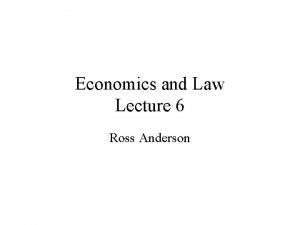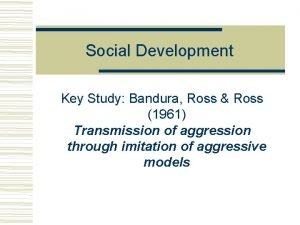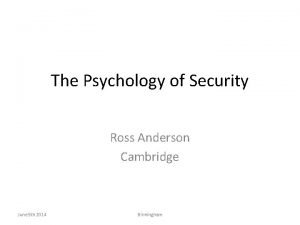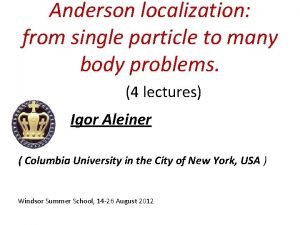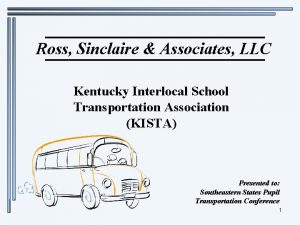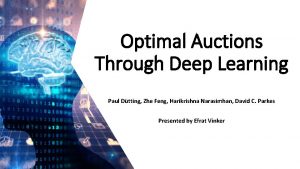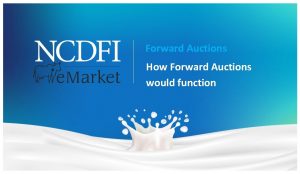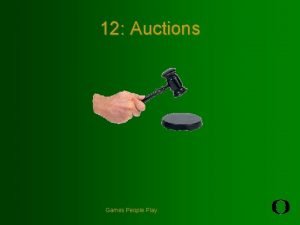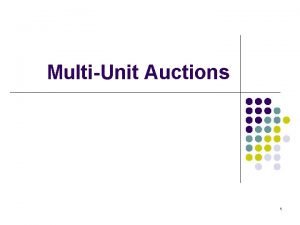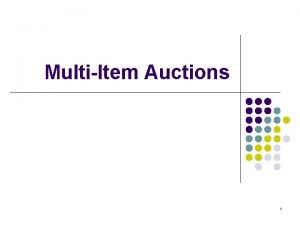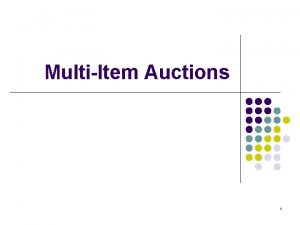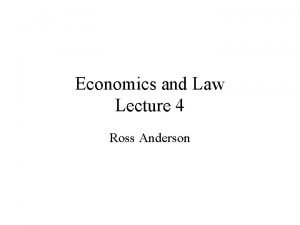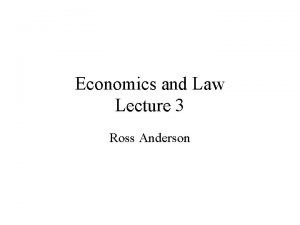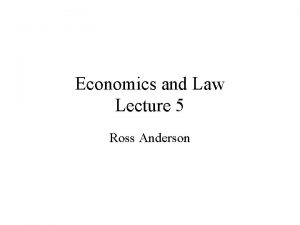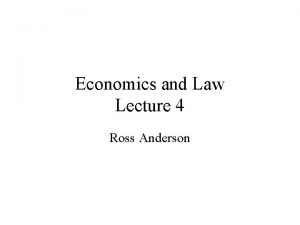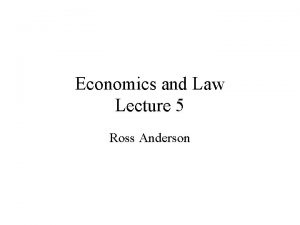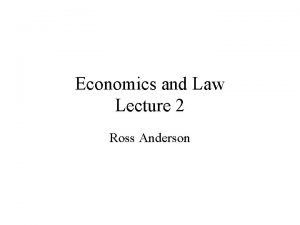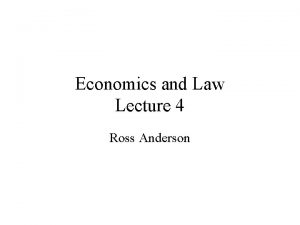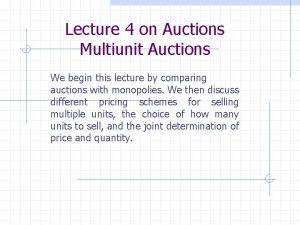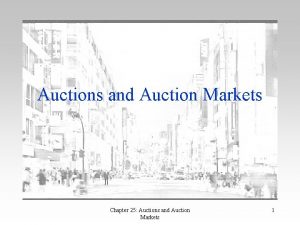Economics and Law Lecture 6 Ross Anderson Auctions

















- Slides: 17

Economics and Law Lecture 6 Ross Anderson

Auctions • Around for millennia; standard way of selling livestock, fine art, mineral rights, bonds… • Many other sales from corporate takeovers to house sales are also really auctions • Auctions are a big success of the Internet, from e. Bay to Google • Spectrum auctions a big deal for tech biz • Rapidly growing interest in theoretical computer science: auction resources in distributed systems • Many issues of asymmetric info, signalling, strategic play… – plus some solid theory!

Types of auction • English, or ascending-bid: start at reserve price and raise till a winner is left (art, antiques) • Dutch, or descending-bid: start high and cut till somebody bids (flowers) • First-price sealed-bid auction: one bid per bidder (government contracts) • Second-price sealed-bid auction, or Vickrey auction: highest bidder wins and pays secondhighest bid (postage stamps) • All-pay auction: everyone pays at every round until one remaining bidder gets the goods (war)

Strategic equivalence • A Dutch auction and a first-price sealed-bid auction give the same result: highest bidder gets goods at his reservation price • They are ‘strategically equivalent’ • Ditto the English auction and the second-price sealed-bid auction (modulo the bid increment) • But the two pairs are not strategically equivalent! – in a second-price auction it’s best to bid truthfully – in a Dutch / first-price auction, you should bid low if you think your valuation is much higher than everybody else’s

Revenue equivalence • This is weaker – not ‘who will win’ but ‘how much money on average’ • According to the revenue equivalence theorem, you get the same revenue from any well-behaved auction under ideal conditions • These include risk-neutral bidders, no collusion, Pareto efficiency (highest value bidder gets goods), suitable reserve price, valuations independent, … • Then the English, Dutch and all-pay auction yield the same – because bidders adjust their strategies • So auction design must focus on departures from the ideal conditions

What goes wrong (1) • In a ‘private-value auction’, each bidder’s value vi is exogenous (think: sculpture). In a second-price auction, everything you buy is a bargain • In a ‘public-value auction’, each item has a true price which bidders estimate at v + I (think mineral leases; spectrum auctions). The buyer is the sucker who overestimated the most! • This is called ‘the winner’s curse’ • Many real auctions somewhere between these two extremes

What goes wrong (2) • Bidding rings – bidders collude to buy low, have a private auction later, split the proceeds • First-price auctions are harder to rig; with secondprice, New Zealand bids of $7 m and $5000 • Entry detection / deterrence: in 1991, ITV franchise auction required bidders to draw up a detailed programming plan. In Midlands & Central Scotland, no competition; bids under 1 p per head (vs £ 9– 16 elsewhere) • Predation: ‘we’ll top any other bid’ in takeovers • Sniping and other boundary effects

What goes wrong (3) • Risk aversion: if you prefer a certain profit of £ 1 to a 50% chance of £ 2, you’ll bid higher at a firstprice auction • Signalling games: show aggression by a large price hike • Simultaneous auctions, as in USA “we want SF, LA, SD and if you compete with us there we’ll push prices up in your patch”) • Budget constraints: if bidders are cash-limited, allpay auctions are more profitable • Externalities between bidders – e. g. arms sales

Combinatorial auctions • Externalities lead to preferences for particular bundles of goods: landing slots at airports, spectrum, mineral rights… • Bid ($x for A+B+C) or ($y for A+D+E) or… • Critial app for CS: routing in presence of congestion (bid for AB and BC, or AD and DC, or…) • The allocation problem is NP-complete; practical algorithms work up to a few thousand objects • Also: how can we make the auction strategy-proof (i. e. truth-telling is the bext strategy)? • New field of ‘algorithmic mechanism design’

Patent • Mechanism to tackle the underprovision of R&D from externality in research • Protects an invention which must be – Novel (“prior art” disallows) – Useful (no perpetual motion machines) – Non-obvious (to “someone skilled in the art”) • Typical duration – 20 years • Traditionally only physical inventions covered; can’t protect ‘the theories above, or the facts beneath’ • However USPTO in particular has really stretched the boundaries, to business methods, genes, …

Patent overstretch • E. g. long fight by ACLU to overturn patents by Myriad on human genome • US 5, 747, 282 (1998) includes any 15 -nucleotide sequence appearing in BRCA 1 breast cancer gene – that’s 1. 6 m sequences of 1. 06 bn possible. • Every human gene contains on average 15 such • Most lab directors had decided not to develop a test / perform a service because of a patent • See “I patent your ass. And your leg. And your nostril”, Ben Goldacre’s ‘Bad Science’ blog, April 2 2010

Trademarks • Marks capable of distinguishing your goods or services from others (e. g. ‘IBM’) • May be registered ( ) or not (™) – registering can make litigation easier • Registered trademark owners usually win domain name disputes • Can sue infringers, but have to show a misrepresentation that damages your business • Pitfalls – some companies are very aggressive about registration and enforcements (Mc. Donalds)

Copyright • Since Statute of Anne (1709– 10), copyright has protected literary works – extending from novels and drama to art, music, and software • No need to register – but asserting copyright ( RJA) can make litigation easier • Duration – has steadily increased over recent years and is now author’s lifetime + 70 years (only 50 years for sound recording rights) • Protects against copying, adaptation etc; “fair use” and “fair dealing” get-outs for criticism, parody… • Moral rights remain with author even if copyright sold

Other ‘IPRs’ • Specialist rights – – Database rights (EU only) US Semiconductor Chip Protection Act Plant breeder’s rights Design rights • Rights based on contract – Materials transfer agreements – Confidential information • Limits – e. g. an employer can’t restrict knowledge that’s become part of the ‘tools of your trade’

Software • Primary protection is copyright • Software patents in theory not allowed in Europe: EPC Art 52 “The following shall not be regarded as inventions … rules and methods for performing mental acts, playing games or doing business, and programs for computers’ • Don’t you believe it! (See Richard Stallman’s talks here on Mar 25 2002, Apr 30 2008) • So far only four CS patents earned serious money • In general, innovation in CS is highly incremental: a large program can use thousands of ideas, while a blockbuster drug is a single patentable molecule

Strategy • ‘IPR’ often a combination (biochip h/w patent + software copyright + MTA on reagents …) • IT industry strategy: portfolios mostly defensive, used to get access by cross-licensing • Startups: VCs like to see some IP (mantra is ‘global sustainable competitive advantage’) • The real game is how you lock customers in • Biggest winnings historically went to those who control platforms and interfaces • Compound models, e. g. GPL the linux version, sell the Windows version, charge for support…

DRM • Copyright owners panicked at printing, audiocassette, videocassette … and now the Internet • Huge push to introduce DRM over last ten years • Not clear that file sharing harms sales • DRM seems to benefit platform vendors more • Yet the legal bandwagon continues from DMCA to ACTA to Digital Economy Bill… • Lexmark v SCC, compared with IPRED • ‘Trusted Computing’ and lock-in • Further reading: Richard Stallman, Pam Samuelson, Suzanne Scotchmer, ORG, EDRI…
 Anderson auctions
Anderson auctions Aggressive role
Aggressive role Ross anderson cambridge
Ross anderson cambridge Anderson localization lecture notes
Anderson localization lecture notes Newton's first law and second law and third law
Newton's first law and second law and third law Newton's first law
Newton's first law Susan mains artist
Susan mains artist Type of auctions
Type of auctions Baystate auctions
Baystate auctions Kista bus sales
Kista bus sales Optimal auctions through deep learning
Optimal auctions through deep learning Ecommerce online auctions
Ecommerce online auctions Would function
Would function Play auctions
Play auctions 01:640:244 lecture notes - lecture 15: plat, idah, farad
01:640:244 lecture notes - lecture 15: plat, idah, farad Maastricht university school of business and economics
Maastricht university school of business and economics Principles of economics powerpoint lecture slides
Principles of economics powerpoint lecture slides Land economics lecture notes
Land economics lecture notes
